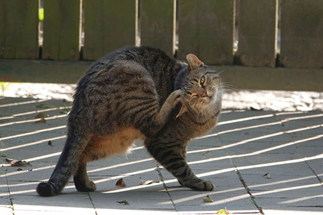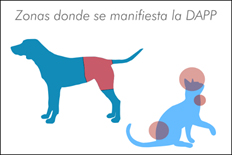
Fleas are one of the most common causes of itching and skin problems in cats and dogs. This aggravating insect not only drives your pet to distraction by biting, but flea saliva can also trigger an allergic reaction that could ruin your pet's shiny coat.
Flea allergy dermatitis (FAD) is one of the most common problems in cats and dogs and, as its name suggests, fleas are the culprits. FAD can turn your pet's life into a real misery. We explain here how to identify FAD, what treatments are available and how to prevent it.
All it takes is one bite
Allergic reactions happen when a body's immune system overreacts. Some pets with FAD develop lumps all over their bodies and cannot stop scratching. When the vet diagnoses this disease, many owners are surprised, "But he doesn't have fleas!" But what they don't usually realise is that one tiny bite is enough to affect the entire animal.
When the adult flea feeds on your pet's blood, it makes a tiny incision in the skin with its mouth and then injects a dose of saliva. Flea saliva contains substances that can be powerful allergens. Although not all cats and dogs will have an allergic reaction, in those that do, it can have a big impact on their quality of life.
How does FAD show up?
The first clue for identifying this type of dermatitis is in their behaviour. If your pet is scratching a lot, or licking or grooming more than normal, they could have a mild case of FAD. Many animals are uncomfortable, unable to sit still, and begin to rub or bite at their skin. In the most severe cases, they can cause themselves serious wounds.

The second clue is on their skin. In the case of dogs, when FAD begins, you may notice a generalised redness or even small red bumps in the area known as the flea triangle: abdomen, lower back, tail base and between the legs. As the condition progresses, you'll see its coat deteriorating; it becomes stained from so much licking and scratching and ends up falling out (alopecia). You'll also see the inflamed areas shedding scales and scabs. In chronic cases, the skin thickens and becomes darker. In the case of cats, the scabbing is most common on the head, neck and lower back.
The third clue is the weather: FAD is more common in the warmer seasons, in other words in spring and summer.

Your vet can diagnose FAD primarily from the symptoms. It is important to adhere to the treatment, and take measures for control and prevention. Sometimes when you don't see many fleas, it's hard to believe they're causing such a big problem. But remember: a single bite is enough to cause this allergy!
My pet has FAD. What do I do now?
The basis of any treatment for FAD is to deal with the fleas. As these insects spend most of their life cycle in the environment and not on your pet, frequent cleaning, vacuuming and disinfection are essential. In severe infestations, it may be necessary to fumigate and apply an IGR molecule in your house. In these cases, it is advisable to consult a pest expert.
As dog or cat owners, the best thing you can do is prevent flea bites by regularly applying spot-on treatments. Dynacan, for example, contains methoprene, a potent IGR that prevents the immature forms from developing. This product also kills adult fleas that are living on your pet in as little as 24 hours. It's a quick and effective solution to the problem of FAD. For complete protection, you can use them along with a flea collar. But be careful, because some are not suitable for cats; if in doubt, ask your vet.
In many cases of FAD, the dermatitis needs to be calmed down, and so your vet may prescribe a corticosteroid, such as prednisone. These drugs work like magic: they relieve the symptoms in the blink of an eye. Of course, they should never be used as the only treatment, as they have significant side effects, especially with prolonged use. The definitive solution is to break the flea cycle.
In severe cases, it's common for your best friend to suffer from secondary yeast or bacterial infections. To combat them, your vet will probably prescribe an antibiotic.
It stands to reason that, upon seeing your pet suffering with itching, your first impulse is to give it a good bath. This will alleviate some of the symptoms of moderate FAD. Your vet can recommend special shampoos that help reduce itching. But do be careful, as too much bathing can dry out the skin, making the itching worse.
Finally, although there are other treatments for flea infestation and FAD on the market, such as desensitisation, the ones discussed here are the most effective.
So, now you know what to do! The key lies in preventing flea bites: ideally use spot-on treatments combined with a good flea collar, and apply them regularly according to the instructions.



